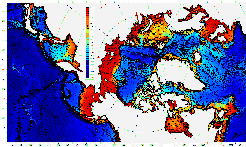 |
U. S. Navy Polar Ice Prediction System Upgrade
|
|
Welcome to the PIPS 3.0 page. This site has been set up to provide a means for investigators associated with the Navy Polar Ice Prediction System upgrade to exchange information and ideas. The goal of PIPS 3.0 is to update PIPS using the latest physics and computational advances in a parallel computing environment.
The model development team welcomes feedback from all interested parties, particularly those who will be running the model operationally at the Fleet Numerical Meteorology and Oceanography Center (FNMOC) in Monterey and the end users at the National Ice Center (NATICE) in Suitland. Some possible areas for comment:
- During model spin-up, processing time for a coupled ice*-ocean model is three hours of processor time per week of integration and seven days of processor time per year of integration on 128 processors of the T3E at the Arctic Region Supercomputer Center in Fairbanks, Alaska. Future testing on DSM machines is planned. Is this fast enough for operational purposes? (* the coupled ice and ocean models are currently earlier reconfigured versions. The ocean model will be upgraded to POP 1.1.1 and the new ice model is discussed on the Ice Model Improvements page.)
- We have improved the vertical resolution in the model so the arctic shelves, continental slopes and submarine ridges are accurately represented hence the 45 levels. This allows 17 levels in the upper 300 m and a maximum layer thickness in the deep ocean of 300m. (click here for vertical resolution information)
- The high vertical resolution raises a question about forcing for the 9 km Stand-Alone Sea Ice Model. What level or levels of temperature, salinity and velocity fields should be archived for use in a stand-alone or coupled sea ice model? Layer 2 in the 9 km ocean model represents circulation from 5-10m. Would a deeper layer be more appropriate, or perhaps an average of several layers, say 5-8 (26-53 m)?
- Any other comments?
Comments/questions can be put on the web or sent directly to Wieslaw Maslowski
Circulation of the Baltic Sea and its connection to the Pan-Arctic region - a large scale and high-resolution modeling approach
(Maslowski, W. and W. Walczowski, Boreal Environment Research, Vol.7, No.4, pp.319-325, 2002)
-
On Large Scale Shift in the Arctic Ocean and Sea Ice Conditions during 1979-1998
(Maslowski et al., Annals of Glaciology, Vol.33, pp.545-550, 2001)
-
Modeling Recent Climate Variability in the Arctic Ocean
(Maslowski et al., Geophys. Res. Ltrs., Vol.27, No.22, pp.3743-3746, 2000)
HTML version (33 kB) PDF version (161 kB)
-
List of other publications (pdf 5.6kB)
Email Address Telephone
Wieslaw Maslowski maslowsk@nps.navy.mil (831) 656-3162
Office:
Oceanography Department
Naval Postgraduate School
833 Dyer Road
Monterey, CA 93943-5122
Fax (831) 656-2712
|
|
|
This is an official U.S. Navy Web site.
Material contained herein is made available for the
purpose of peer review and discussion
and does not necessarily reflect the views
of the Department of the Navy or the Department of Defense.
- Last modified 01 August 2003 -
Web site comments or questions?
E-mail the Web Author


